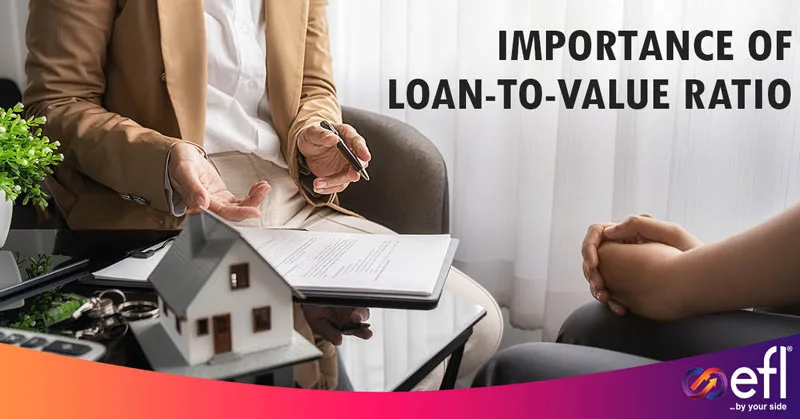Understanding the Loan-to-Value (LTV) ratio is important to gain control of one’s finances. Whether you are a borrower seeking a loan against your property (BLAP) or a lender evaluating loan applications, understanding the LTV ratio can significantly impact the outcome of the deal. This blog post sheds light on the significance of the LTV ratio in the Indian context and how it influences borrowing and lending decisions.
What is a Loan-to-Value Ratio?
Loan-to-Value Ratio, or LTV, is a key financial metric used to assess the risk and eligibility associated with loans secured by assets such as real estate. It represents the ratio of the loan amount to the appraised value of the property. In simpler terms, it helps determine how much of the property’s value can be financed through a loan.
How to Calculate the Loan-to-Value Ratio
Calculate the LTV ratio by dividing the loan amount by the appraised value of the property multiplied by 100.
For example, a borrower requires a loan against property of INR 90 lakhs. The lender, after cross-checking all requirements and necessary documents, confirms that the loan amount to be sanctioned is INR 75 lakhs. Then, the loan-to-value ratio will be as follows:
LTV = (75/90) x 100 = 83%
The LTV as well as the BLAP amount is also determined depending on the condition of the property. If the property is older, the value will probably not increase over time, which attracts lower loan amounts.
From the lender’s point of view, a lower loan-to-value ratio is appropriate as it requires the borrower to pay more of their own funds upfront, which implies a higher level of commitment from the borrower. However, in these situations, the lenders will quote higher interest rates to minimise the risk of a high LTV. That means the loan-to-value ratio is directly proportional to the loan interest rate. Lenders also have to consider the maturity of the property. Older properties tend to depreciate over time, which could become a burden on the lenders.
From the borrower’s point of view, a higher loan-to-value ratio is more cost-effective as it allows the borrower to negotiate not only the tenure of the loan against property but also a lesser interest rate.
From either perspective, the loan-to-value ratio is an important aspect of the loan. To understand whether you are eligible for an BLAP, you can use the loan against property calculator, available on the Electronica Finance Limited website.
Electronica Finance Limited provides a business loan against property with a maximum loan amount of Rs. 3cr, repayment up to 84 months, and a loan-to-value ratio of up to 70% of the property value.
Electronica Finance Limited also allows borrowers to keep industrial property as collateral.
Understanding the Loan-to-Value (LTV) Ratio
The LTV ratio is a fundamental concept in the world of lending. It plays a crucial role in determining the risk associated with a loan and in setting the terms and conditions of the loan.
Factors that Impact the Loan-to-Value Ratio
Several factors can influence the LTV ratio. Among these, the most significant are the property’s current market value and the amount of the loan requested. A higher LTV ratio indicates a greater financial risk for the lender.
Why is the LTV Ratio Important?
Understanding the LTV ratio is essential for both borrowers and lenders. The LTV ratio is significant because it helps in gauging the level of risk associated with a loan. It provides lenders with insights into the borrower’s financial stability and their capacity to repay the loan.
How Does it Affect your Eligibility?
The LTV ratio also has a direct impact on a borrower’s eligibility for loans. A high LTV ratio may limit a borrower’s options, while a lower ratio can open more favourable borrowing terms.
What is a Good and a Bad Loan-to-Value Ratio?
A “good” or “bad” LTV ratio depends on several factors, including the lender’s policies and the type of loan being sought. However, a lower LTV ratio is generally considered more favourable, as it indicates a lower risk for the lender.
How do Lenders use the LTV Ratio?
Financial institutions use the LTV ratio as a critical factor in their lending decisions. A lower LTV is often preferred as it minimises the lender’s risk.
What Are the Disadvantages of LTV?
While the LTV ratio is a valuable tool, it is not without its limitations. It may not consider all aspects of a borrower’s financial health, and sometimes, it might lead to conservative lending decisions.
How do Financial Institutions use the Loan-to-Value Ratio?
Financial institutions employ LTV ratios to ensure they are making sound lending decisions. They consider not only the borrower’s creditworthiness but also the value of the asset being used as collateral.
What are the RBI Guidelines for LTV?
The Reserve Bank of India (RBI) plays a vital role in regulating lending practices in the country. RBI has established specific guidelines concerning LTV ratios in lending to maintain the stability of the financial system.
Conclusion
The Loan-to-Value (LTV) ratio is a pivotal component of the Loan Against Property (BLAP) landscape in India. Understanding its nuances is crucial for both borrowers and lenders. It not only influences eligibility and terms but also helps in maintaining the financial stability of the lending industry. Whether you are a prospective borrower or a financial institution, embracing the importance of LTV ratios can lead to more informed, secure, and beneficial lending and borrowing decisions.
At Electronica Finance Limited, we are committed to providing financial solutions that cater to the unique needs of our clients. With over 30 years of experience, we have served more than 25,000 customers, offering customised, hassle-free loans with no collateral requirements and a transparent application process.
For more information on our financial services, including Loan Against Property, visit our official website. We are here to support you every step of the way, ensuring you make the most informed decisions for your financial well-being.
FAQs
Why is LTV risky?
LTV can be risky because it represents the proportion of the property’s value that is financed through a loan. A higher LTV means a larger loan relative to the property’s value, increasing the borrower’s financial risk. In the event of property value depreciation or economic downturn, a high LTV can lead to negative equity, making it challenging for the borrower to sell the property or refinance the loan.
Is a 40% LTV ratio good?
A 40% LTV is generally considered favourable. It signifies that the borrower is financing 40% of the property’s value, leaving a substantial equity cushion. This can lead to more favourable mortgage terms and a lower risk for lenders.
What is the ideal LTV Ratio?
The ideal LTV ratio can vary depending on the lender, the type of loan, and the borrower’s financial situation. However, a lower LTV, typically around 70% or lower, is often seen as ideal as it provides a significant equity buffer and more favourable borrowing terms.
Is a higher or lower LTV better?
In most cases, a lower LTV is better. It indicates a larger down payment and less financial risk. Higher LTVs can lead to less favourable mortgage terms and increased financial risk for borrowers.
What is the LTV ratio for a loan against property?
The LTV ratio for a loan against property varies among lenders and depends on several factors, including the property’s value and the borrower’s creditworthiness. Typically, lenders in India may offer LTV ratios ranging from 50% to 70% for loans against property.
What is the highest LTV in a loan against property?
The LTV ratio for a loan against property depends on the lender and the specific terms of the loan. In some cases, it can go up to 70% or slightly higher, but it varies based on the lender’s policies.
Can I get a 90% LTV home loan?
Getting a 90% LTV home loan is possible with some lenders, but it may come with maximum interest rates and more stringent requirements. Borrowers should have a strong credit profile and meet the lender’s criteria to qualify for such a high LTV.
What is the LTV for residential property?
The LTV for residential property loans can vary, but it typically ranges from 70% to 80%. This means that borrowers may be required to finance 20% to 30% of the property’s value themselves.
What is the most important factor that determines the value of a loan?
While LTV is important, the most critical factor that determines the value of a loan is the borrower’s creditworthiness. Lenders assess factors like credit history, income, and debt-to-income ratio to determine the loan amount, loan terms and interest rates.
Is it good to have a low loan-to-value ratio?
Yes, having a low loan-to-value (LTV) ratio is generally advantageous. It signifies a significant equity stake in the property and is associated with better mortgage terms and lower financial risk for the borrower.
What is loan-to-value ratio in India?
In India, the loan-to-value (LTV) ratio is a critical factor in the lending industry. It represents the ratio of the loan amount to the appraised value of the property and plays a significant role in determining loan eligibility and terms.



